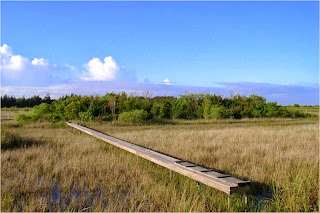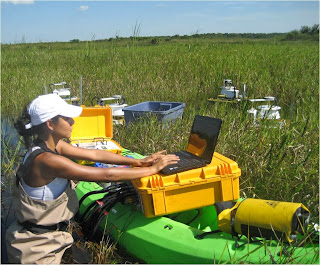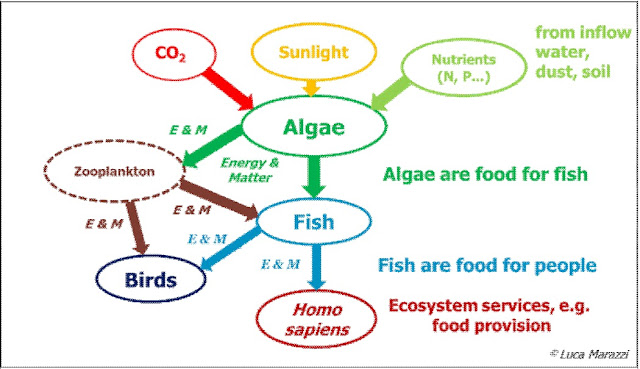Carbon dynamics from reconstructed (LILA) tree islands in the Everglades
This post was written by guest blogger Alexandra Serna, a post-doctoral researcher in the FIU Freshwater Biogeochemistry Lab (http://www2.fiu.edu/~fwbgchem/), about some of her work on tree islands and carbon dynamics in the Everglades.
___________________________________________________________________________
 A few weeks ago, I attended the American Society of
Agronomy, Crop Science Society of America, and Soil Science Society of America
Annual Meetings in Tampa, FL. What a huge conference! My colleagues and I
presented our most recent data on tree island Carbon (C) dynamics. Tree islands
are one of the most prominent landscape features of the Everglades system.
Despite their importance, hydrologic modifications to the system have greatly
altered the number, size, and distribution of tree islands in the Everglades.
The original peat-accreting system stored large quantities of soil C and was a
sink for atmospheric CO2. Hydrologic manipulation and wide-spread drainage have
caused the oxidation, subsidence, and loss of large quantities of soil C. An
important aspect of the Everglades ecosystem restoration is an attempt to
reestablish a more natural hydrology. Increased freshwater flows through the
Greater Everglades Ecosystem (GEE) are expected as a result of projects planned
to enhance water delivery. However, the degree to which changes in water
delivery will affect the tree islands is uncertain.Our work provides a
before-intervention study conducted in the Loxahatchee Impoundment Landscape
Assessment (LILA) facility (Boynton Beach, Florida). LILA is a research
platform that supports the LTER project by defining hydrologic regimes that
contribute to the preservation of existing tree island and potential mechanisms
for tree island restoration/creation. LILA consists of four macrocosms, that
mimic Everglades ridge, slough and tree island landscape structure. LILA
exemplifies the tree islands found in the GEE and across the FCE-LTER landscape
by having two types of constructed tree islands; those
A few weeks ago, I attended the American Society of
Agronomy, Crop Science Society of America, and Soil Science Society of America
Annual Meetings in Tampa, FL. What a huge conference! My colleagues and I
presented our most recent data on tree island Carbon (C) dynamics. Tree islands
are one of the most prominent landscape features of the Everglades system.
Despite their importance, hydrologic modifications to the system have greatly
altered the number, size, and distribution of tree islands in the Everglades.
The original peat-accreting system stored large quantities of soil C and was a
sink for atmospheric CO2. Hydrologic manipulation and wide-spread drainage have
caused the oxidation, subsidence, and loss of large quantities of soil C. An
important aspect of the Everglades ecosystem restoration is an attempt to
reestablish a more natural hydrology. Increased freshwater flows through the
Greater Everglades Ecosystem (GEE) are expected as a result of projects planned
to enhance water delivery. However, the degree to which changes in water
delivery will affect the tree islands is uncertain.Our work provides a
before-intervention study conducted in the Loxahatchee Impoundment Landscape
Assessment (LILA) facility (Boynton Beach, Florida). LILA is a research
platform that supports the LTER project by defining hydrologic regimes that
contribute to the preservation of existing tree island and potential mechanisms
for tree island restoration/creation. LILA consists of four macrocosms, that
mimic Everglades ridge, slough and tree island landscape structure. LILA
exemplifies the tree islands found in the GEE and across the FCE-LTER landscape
by having two types of constructed tree islands; those
where peat soils were sculpted to create topographic high, or where limestone cores were established and then covered to the same final elevations as the peat islands. These two core types are meant to represent tree islands from the northern and southern Everglades, respectively.
 The objective of our work is to study vegetation
and water flow interactions and how they influence C dynamics of Everglades
tree islands. We developed an empirically-based model for tree island soil based
on production and decomposition of organic matter as influenced by water depth
fluctuations. Soil respiration (CO2 efflux), litter (organic matter)
production, soil accretion (C sequestration) and soil elevation change
measurements were balanced in two types of LILA tree islands (peat or limestone
cores) at different water depth (high and low elevation). The higher elevations
(drier) of the tree islands generally had higher biomass, litter production,
and soil accretion. Peat core islands favor a more productive tree island plant
community, but peat islands tend to subside more rapidly than limestone
islands. In the peat islands and at higher elevations, trees were maximally
productive. The centers of the tree islands seem to be losing elevation despite
the fact that soil is being accreted at the greatest rate in these locations.
There are several possible reasons for the loss in elevation, including root
decomposition, sediment compaction since tree island creation, and groundwater
withdrawal. Higher rates of CO2 efflux (i.e., soil respiration) occurred in the
head of the tree islands at high elevation, coinciding with higher litter
production and biomass. To date, our work has shown that production and soil accretion
in relatively young (~6 years old) LILA tree islands do not build topography at
a rate to compete with settling/subsidence.
The objective of our work is to study vegetation
and water flow interactions and how they influence C dynamics of Everglades
tree islands. We developed an empirically-based model for tree island soil based
on production and decomposition of organic matter as influenced by water depth
fluctuations. Soil respiration (CO2 efflux), litter (organic matter)
production, soil accretion (C sequestration) and soil elevation change
measurements were balanced in two types of LILA tree islands (peat or limestone
cores) at different water depth (high and low elevation). The higher elevations
(drier) of the tree islands generally had higher biomass, litter production,
and soil accretion. Peat core islands favor a more productive tree island plant
community, but peat islands tend to subside more rapidly than limestone
islands. In the peat islands and at higher elevations, trees were maximally
productive. The centers of the tree islands seem to be losing elevation despite
the fact that soil is being accreted at the greatest rate in these locations.
There are several possible reasons for the loss in elevation, including root
decomposition, sediment compaction since tree island creation, and groundwater
withdrawal. Higher rates of CO2 efflux (i.e., soil respiration) occurred in the
head of the tree islands at high elevation, coinciding with higher litter
production and biomass. To date, our work has shown that production and soil accretion
in relatively young (~6 years old) LILA tree islands do not build topography at
a rate to compete with settling/subsidence.
 Overall, there was an effect of both water depth
and island core type on C inputs/outputs. Carbon balance estimates to date have
been made on young LILA tree islands at preliminary stages of formation. These
mechanisms (e.g., litterfall leading to soil accretion) are developing and it
is expected that further development will change estimates of C dynamics. Our
research helped to balance present-day C inputs/outputs in the altered
Everglades ecosystem. Understanding how Everglades tree islands soil
respiration responds to water depth fluctuations coupled with organic matter
production and soil accretion can be used by managers to slow or reverse tree
island loss. Carbon cycling has always been and continues to be a primary research
goal in the FCE-LTER Program.
Overall, there was an effect of both water depth
and island core type on C inputs/outputs. Carbon balance estimates to date have
been made on young LILA tree islands at preliminary stages of formation. These
mechanisms (e.g., litterfall leading to soil accretion) are developing and it
is expected that further development will change estimates of C dynamics. Our
research helped to balance present-day C inputs/outputs in the altered
Everglades ecosystem. Understanding how Everglades tree islands soil
respiration responds to water depth fluctuations coupled with organic matter
production and soil accretion can be used by managers to slow or reverse tree
island loss. Carbon cycling has always been and continues to be a primary research
goal in the FCE-LTER Program.
___________________________________________________________________________
 A few weeks ago, I attended the American Society of
Agronomy, Crop Science Society of America, and Soil Science Society of America
Annual Meetings in Tampa, FL. What a huge conference! My colleagues and I
presented our most recent data on tree island Carbon (C) dynamics. Tree islands
are one of the most prominent landscape features of the Everglades system.
A few weeks ago, I attended the American Society of
Agronomy, Crop Science Society of America, and Soil Science Society of America
Annual Meetings in Tampa, FL. What a huge conference! My colleagues and I
presented our most recent data on tree island Carbon (C) dynamics. Tree islands
are one of the most prominent landscape features of the Everglades system.where peat soils were sculpted to create topographic high, or where limestone cores were established and then covered to the same final elevations as the peat islands. These two core types are meant to represent tree islands from the northern and southern Everglades, respectively.
 The objective of our work is to study vegetation
and water flow interactions and how they influence C dynamics of Everglades
tree islands. We developed an empirically-based model for tree island soil based
on production and decomposition of organic matter as influenced by water depth
fluctuations. Soil respiration (CO2 efflux), litter (organic matter)
production, soil accretion (C sequestration) and soil elevation change
measurements were balanced in two types of LILA tree islands (peat or limestone
cores) at different water depth (high and low elevation). The higher elevations
(drier) of the tree islands generally had higher biomass, litter production,
and soil accretion. Peat core islands favor a more productive tree island plant
community, but peat islands tend to subside more rapidly than limestone
islands. In the peat islands and at higher elevations, trees were maximally
productive. The centers of the tree islands seem to be losing elevation despite
the fact that soil is being accreted at the greatest rate in these locations.
There are several possible reasons for the loss in elevation, including root
decomposition, sediment compaction since tree island creation, and groundwater
withdrawal. Higher rates of CO2 efflux (i.e., soil respiration) occurred in the
head of the tree islands at high elevation, coinciding with higher litter
production and biomass. To date, our work has shown that production and soil accretion
in relatively young (~6 years old) LILA tree islands do not build topography at
a rate to compete with settling/subsidence.
The objective of our work is to study vegetation
and water flow interactions and how they influence C dynamics of Everglades
tree islands. We developed an empirically-based model for tree island soil based
on production and decomposition of organic matter as influenced by water depth
fluctuations. Soil respiration (CO2 efflux), litter (organic matter)
production, soil accretion (C sequestration) and soil elevation change
measurements were balanced in two types of LILA tree islands (peat or limestone
cores) at different water depth (high and low elevation). The higher elevations
(drier) of the tree islands generally had higher biomass, litter production,
and soil accretion. Peat core islands favor a more productive tree island plant
community, but peat islands tend to subside more rapidly than limestone
islands. In the peat islands and at higher elevations, trees were maximally
productive. The centers of the tree islands seem to be losing elevation despite
the fact that soil is being accreted at the greatest rate in these locations.
There are several possible reasons for the loss in elevation, including root
decomposition, sediment compaction since tree island creation, and groundwater
withdrawal. Higher rates of CO2 efflux (i.e., soil respiration) occurred in the
head of the tree islands at high elevation, coinciding with higher litter
production and biomass. To date, our work has shown that production and soil accretion
in relatively young (~6 years old) LILA tree islands do not build topography at
a rate to compete with settling/subsidence. Overall, there was an effect of both water depth
and island core type on C inputs/outputs. Carbon balance estimates to date have
been made on young LILA tree islands at preliminary stages of formation. These
mechanisms (e.g., litterfall leading to soil accretion) are developing and it
is expected that further development will change estimates of C dynamics. Our
research helped to balance present-day C inputs/outputs in the altered
Everglades ecosystem. Understanding how Everglades tree islands soil
respiration responds to water depth fluctuations coupled with organic matter
production and soil accretion can be used by managers to slow or reverse tree
island loss. Carbon cycling has always been and continues to be a primary research
goal in the FCE-LTER Program.
Overall, there was an effect of both water depth
and island core type on C inputs/outputs. Carbon balance estimates to date have
been made on young LILA tree islands at preliminary stages of formation. These
mechanisms (e.g., litterfall leading to soil accretion) are developing and it
is expected that further development will change estimates of C dynamics. Our
research helped to balance present-day C inputs/outputs in the altered
Everglades ecosystem. Understanding how Everglades tree islands soil
respiration responds to water depth fluctuations coupled with organic matter
production and soil accretion can be used by managers to slow or reverse tree
island loss. Carbon cycling has always been and continues to be a primary research
goal in the FCE-LTER Program.
The meeting was an excellent opportunity to discuss
experiences with other scientists with similar interests and to get
constructive feedback from experts in the field. I thank the FCE LTER for
partially funding my trip through the 2013 LTER Student Travel Award for post
docs and technicians. It gave me the opportunity to present our work and also
meeting not only established members of the scientific community, but experts
from the industry and consulting sectors.


Comments
Post a Comment